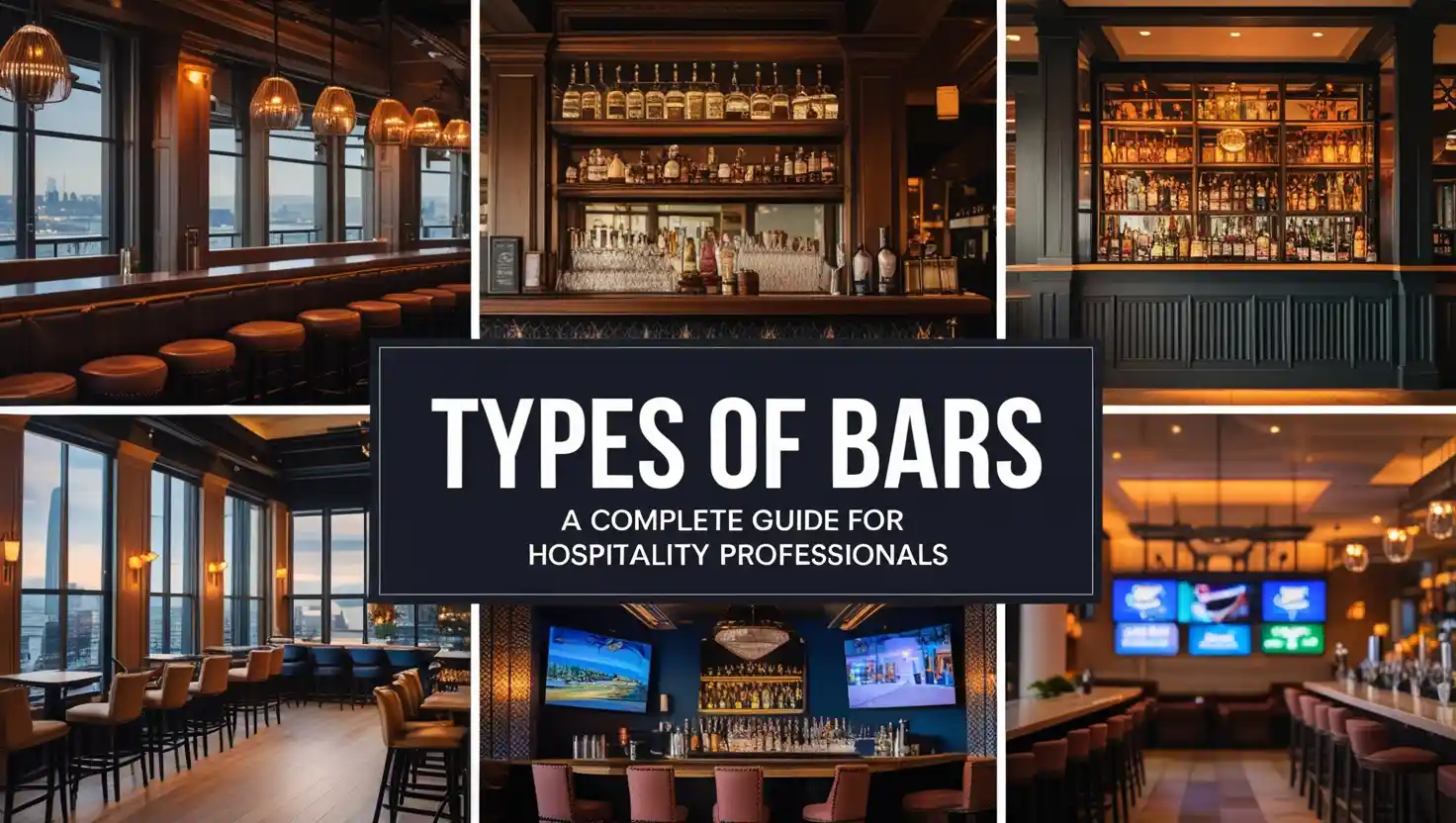Bars are more than just places where drinks are served. They are integral components of the food and beverage (F&B) service industry, offering diverse experiences based on concept, ambience, clientele, and service style. For hotel management students and professionals, understanding the different types of bars is essential not only for theoretical knowledge but also for practical, real-world application.
Whether you’re working in a five-star hotel, managing a cruise ship bar, or launching your own hospitality business, this guide will equip you with detailed insights into the wide spectrum of bar types.
We will cover everything from traditional pubs to cutting-edge rooftop lounges, giving you an edge in both academics and your career.
Quick Overview: Explore the 23 Types of Bars in the Hospitality Industry
This infographic gives you a quick glance at popular, speciality, and emerging bar concepts—from traditional pubs to modern experiential venues.
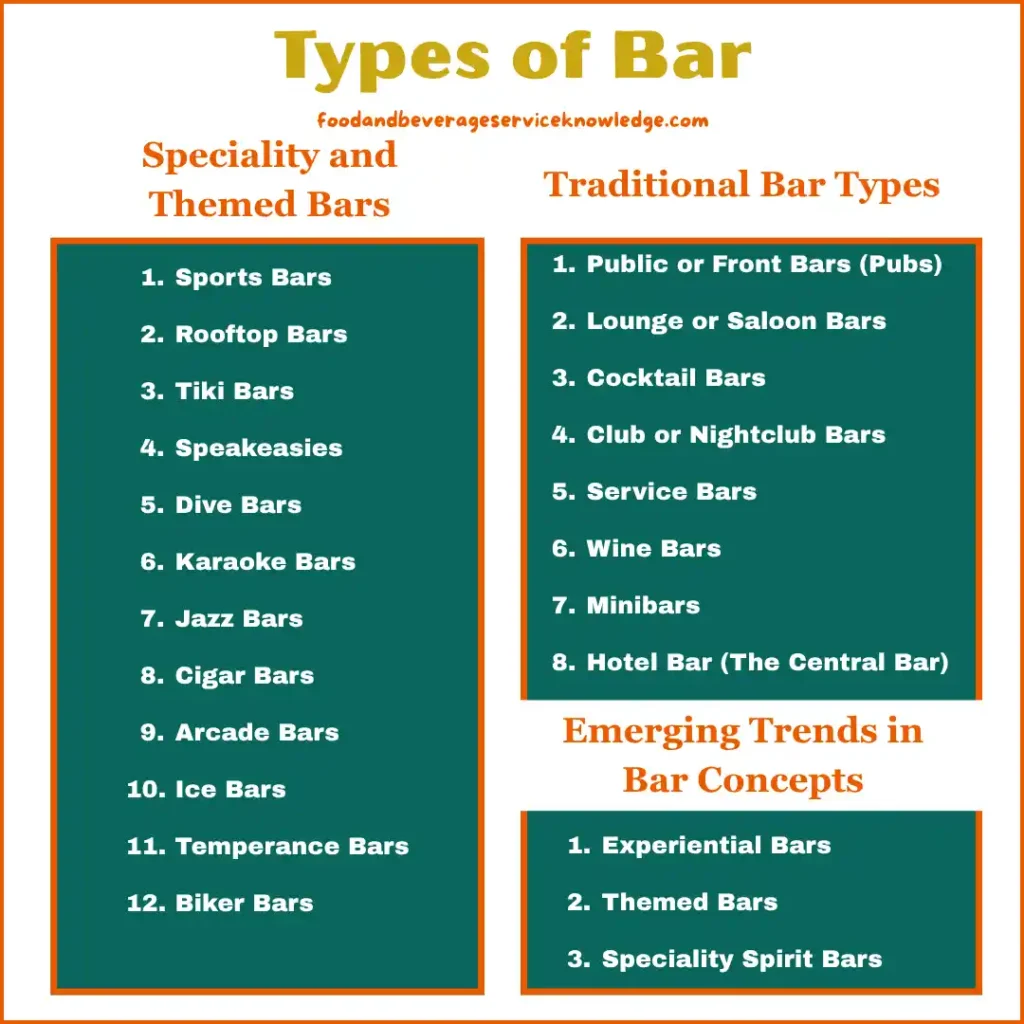
Traditional Bar Types:
1. Public or Front Bars (Pubs)
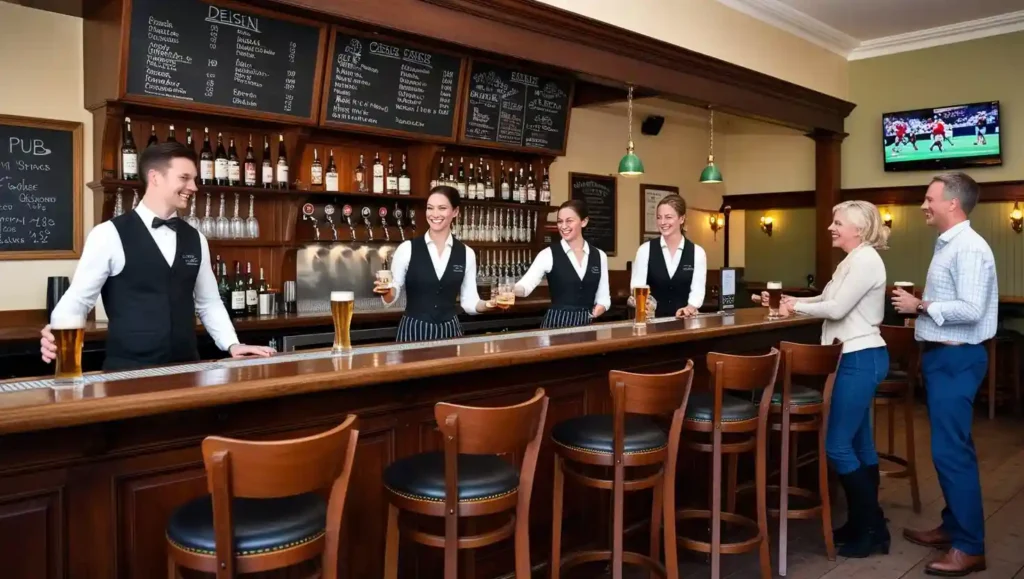
Public bars, commonly known as pubs, are accessible drinking establishments serving the general public. They feature large, open areas where drinks are served over the counter. Pubs often offer affordable types of beverages, including beer, cider, and basic spirits, along with simple food menus. Entertainment such as live sports or music is common. They serve as social hubs for local communities.
Key Features:
- Informal ambience with basic furnishings
- Affordable pricing and community-focused atmosphere
Example: The Churchill Arms – London. A historic London pub known for its floral exterior and authentic Thai cuisine, offering a casual and community-centred atmosphere.
2. Lounge or Saloon Bars
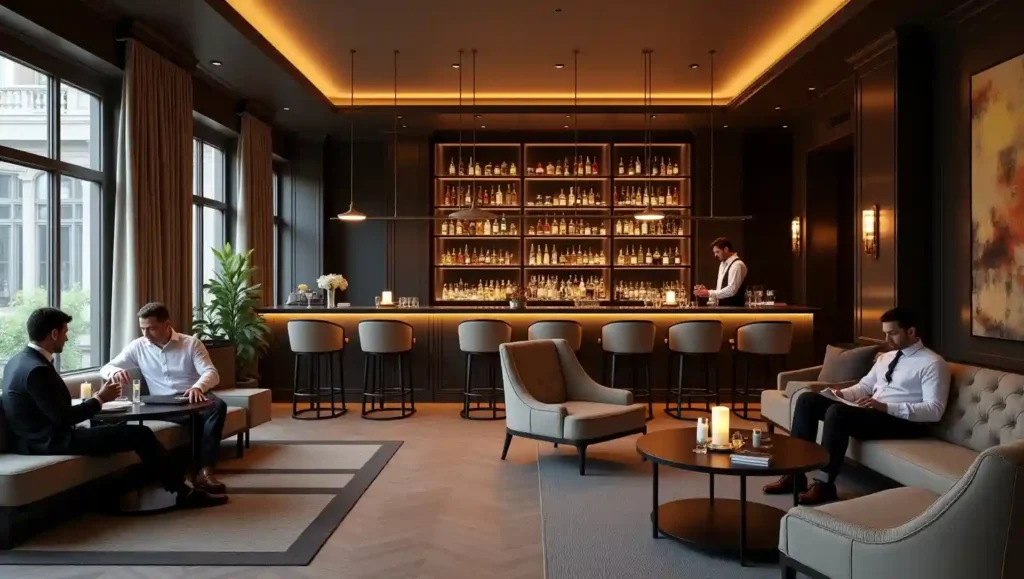
Lounge bars provide a quieter, more relaxed environment compared to public bars. They are designed for guests seeking comfort and a refined experience. These bars feature comfortable seating and ambient lighting. A selection of premium beverages is typically available. Personalised service enhances the guest experience.
Key Features:
- Comfortable seating with ambient lighting
- Premium beverage selection and personalised service
Example: The American Bar at The Savoy – London. An iconic cocktail lounge offering a refined setting with ambient lighting and personalized service, perfect for guests seeking comfort and sophistication.
3. Cocktail Bars
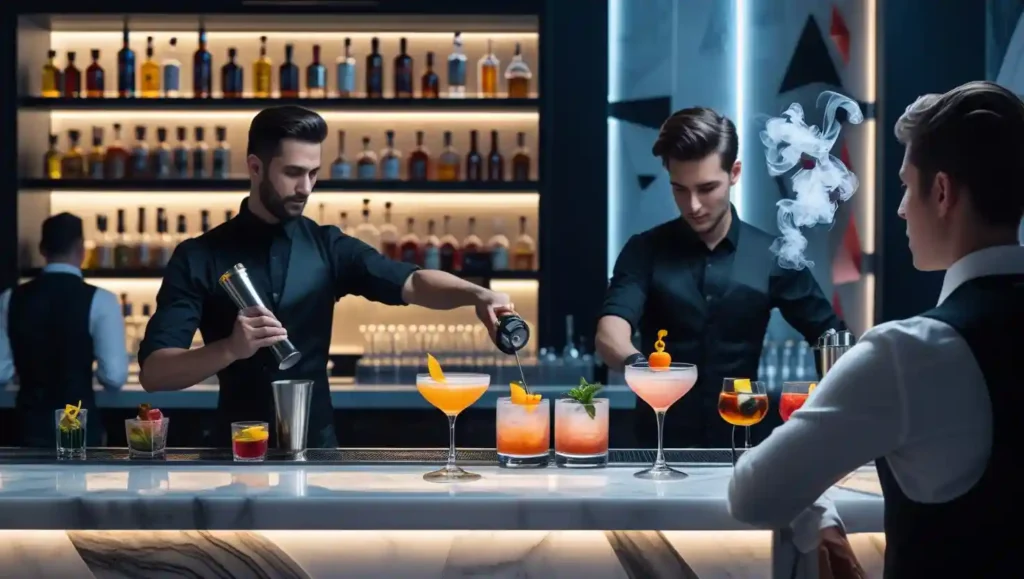
Cocktail bars specialise in serving a wide variety of mixed drinks and classic cocktails. Bartenders often exhibit high levels of skill, including flair bartending. The decor ranges from elegant to avant-garde. Creative glassware and garnishing are common. These bars cater to urban drinkers and those interested in mixology.
Key Features:
- Signature and custom cocktails with high-end ingredients
- Creative presentation and skilled bartending
Example: Death & Co – New York. A renowned cocktail bar specialising in innovative mixology and creative drink presentations in a sleek, upscale environment.
4. Club or Nightclub Bars
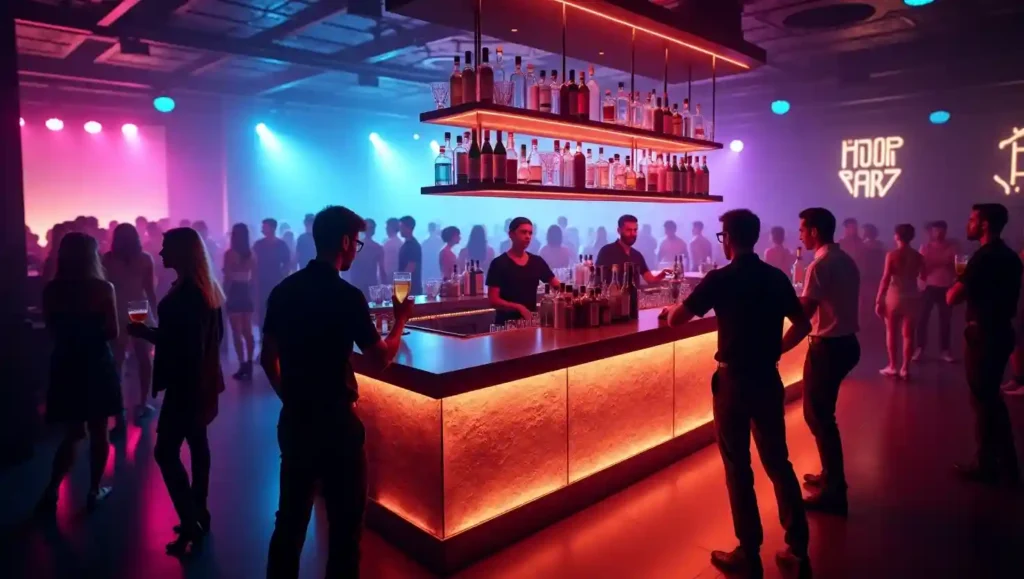
Nightclubs feature bars as part of their broader entertainment offerings, including music and dancing. They are characterised by loud music, dance floors, and mood lighting. Strict age and dress codes are often enforced. Bars focus on fast service to accommodate high volume. They attract younger demographics and nightlife enthusiasts.
Key Features:
- High-energy environment with music and dancing
- Fast-paced bar service catering to large crowds
Example: Omnia Nightclub – Las Vegas. A high-energy nightclub featuring world-class DJs, vibrant lighting, and fast-paced bar service catering to large crowds.
5. Service Bars
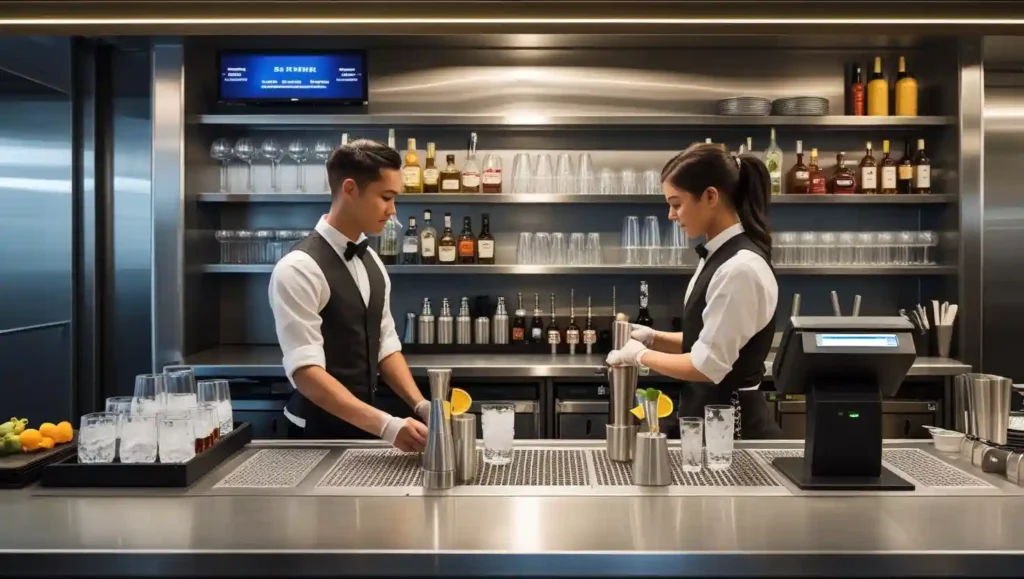
Service bars are located in the back-of-house areas of restaurants or hotels. They are used by waitstaff to prepare and deliver drinks to seated guests. These bars are not accessible to customers directly. Efficient layout supports speed and volume. They are integrated with point-of-sale systems.
Key Features:
- Staff-only access for efficient drink preparation
- Supports quick and organised service flow
Example: The Bar Room at The Modern – New York. A behind-the-scenes service bar where staff efficiently prepare beverages for seated guests in a fine dining setting.
6. Wine Bars
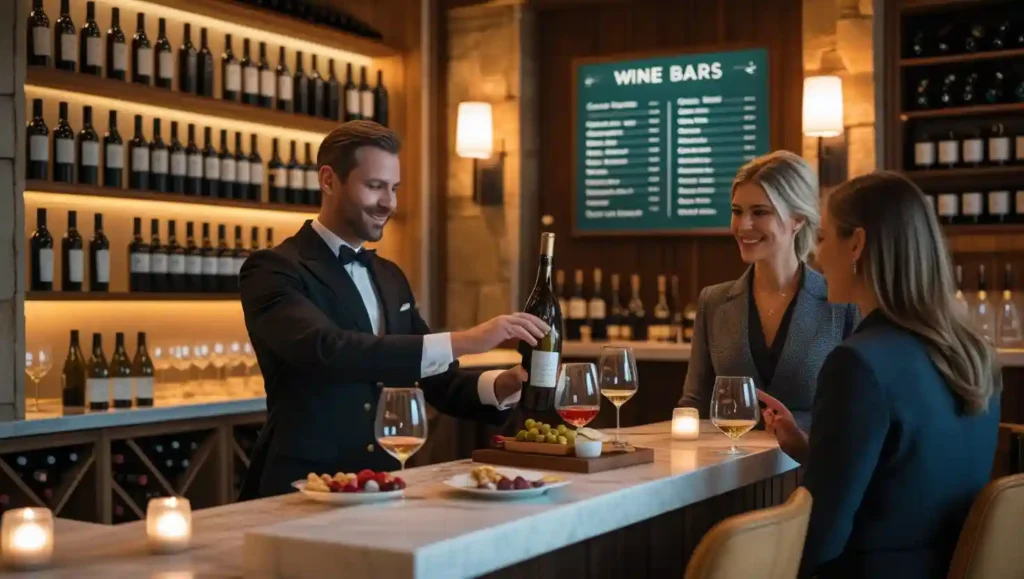
Wine bars specialise in offering curated selections of wines. They often emphasise wine education through tastings. Light gourmet snacks or tapas are commonly served. Elegant and cosy interiors create a refined atmosphere. They cater to wine aficionados and upscale clientele.
Key Features:
- Extensive wine selection with educational tastings
- Elegant ambience with light gourmet offerings
7. Minibars
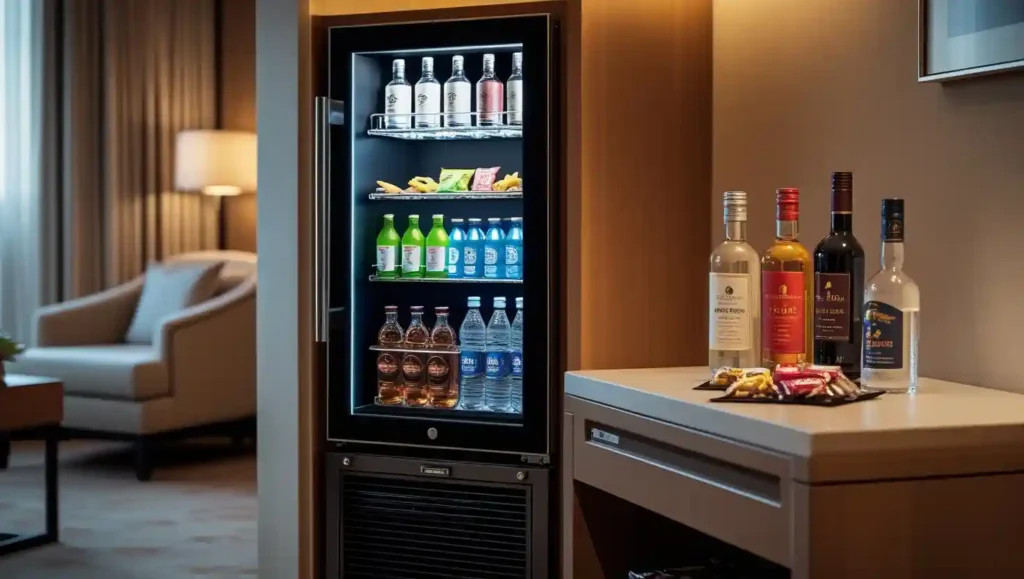
Minibars are small refrigerated units placed in hotel rooms. They are stocked with premium beverages and snacks, offering guests effortless in-room refreshment and complementing room service options. Modern setups may include automated inventory tracking. Selections often include alcoholic and non-alcoholic drinks, chocolates, and nuts.
Key Features:
- In-room convenience with a variety of refreshments
- Automated systems for efficient inventory management
Example: The Ritz-Carlton, Tokyo. Experience in-room convenience with a variety of refreshments, including premium beverages and snacks, managed through automated systems.
8. Hotel Bar (The Central Bar)

The hotel Bar is the primary bar outlet in a hotel that serves as the central location for beverage service. It is typically located near the hotel’s main dining area or guest lounge, offering a wide variety of alcoholic and non-alcoholic drinks. This bar is open to all hotel guests and often operates throughout the day.
It is designed to be versatile, accommodating both casual and semi-formal guest interactions. The hotel Bar is a key part of the hotel’s food and beverage operations and contributes to the overall guest experience.
Key Features:
- Offers cocktails, spirits, wines, beers, mocktails, juices, and hot beverages to suit all guest preferences.
- Typically situated in a high-traffic guest area, like near the main restaurant or lounge, maximising accessibility and visibility.
Example: The Bar at Clement – The Peninsula New York. A centrally located hotel bar offering a full range of drinks in a stylish, welcoming setting, accommodating both casual and semi-formal interactions.
Related: Types of Food and Beverage Outlets: A Guide for Hospitality Professionals
Speciality and Themed Bars:
9. Sports Bars
Sports bars are centred around live sporting events. They provide a communal viewing experience with multiple large-screen TV. Game-time food specials and bar games like pool or darts are common. Team-themed decor enhances the sports atmosphere. They attract sports fans, groups of friends, and casual diners.
Key Features:
- Multiple screens broadcasting live sports
- Interactive games and themed decor
Example: Buffalo Wild Wings – USA. A popular sports bar chain with multiple large-screen TVs, game-day specials, and a lively, communal viewing environment perfect for fans.
10 Rooftop Bars
Rooftop bars are located on the rooftops of buildings or hotels. They offer panoramic views of city skylines or scenic landscapes. Aesthetic appeal is enhanced with stylish decor. Often seasonal, they consider weather conditions. Premium pricing reflects the unique ambience.
Key Features:
- Scenic views with stylish and modern design
- Exclusive atmosphere with premium offerings
11. Tiki Bars
Tiki bars are Polynesian-inspired venues serving tropical, often rum-based, drinks. They feature bamboo furniture and island-style decor. Drinks like Mai Tais and Piña Coladas are common. Exotic fruits and colourful garnishes enhance the presentation. They offer a playful and relaxed vibe.
Key Features:
- Tropical-themed decor with exotic cocktails
- Relaxed atmosphere reminiscent of island getaways
Example: Smuggler’s Cove – San Francisco. A renowned tiki bar featuring tropical rum-based cocktails, bamboo décor, and exotic garnishes in a fun, island-inspired ambience.
12. Speakeasies
Speakeasies are modelled after Prohibition-era bars with hidden or secretive entrances. They offer vintage decor and a quiet environment. Menus focus on classic and craft cocktails. Limited seating maintains exclusivity. They appeal to cocktail purists and romantics.
Key Features:
- Hidden entrances with vintage, intimate settings
- Focus on classic cocktails and exclusivity
Example: PDT (Please Don’t Tell) – New York City. A hidden Prohibition-style speakeasy with vintage decor, classic cocktails, and a secret phone booth entrance inside a hot dog shop.
13. Dive Bars
Dive bars are no-frills, local establishments known for affordability and authenticity. They feature basic drinks at low prices. Interiors are unpretentious and often worn. Cash-only policies are common. They attract loyal, local clientele.
Key Features:
- Unpretentious atmosphere with affordable drinks
- Strong community presence with regular patrons
14. Karaoke Bars
Karaoke bars are equipped with machines allowing patrons to perform songs. They offer open-mic or private booth experiences. Songbooks and touchscreens facilitate song selection. The atmosphere is fun and participatory. Asian snacks and cocktails are often served.
Key Features:
- Interactive entertainment with singing opportunities
- Casual setting promoting group participation
14. Karaoke Bars
Example: Sing Sing Karaoke – New York City. Lively karaoke venue offering open mic and private booths, casual food, and fun group entertainment with a laid-back vibe.
15. Jazz Bars
Jazz bars are dedicated to live jazz music performances. They offer an artistic and relaxed environment. Intimate spaces with dim lighting enhance the experience. High-end drinks are typically available with table service. They attract older patrons and music enthusiasts.
Key Features:
- Live jazz performances in intimate settings
- Sophisticated ambience with premium offerings
Example: The Jazz Showcase – Chicago. An iconic jazz bar presenting live performances in an intimate space with table service and a sophisticated musical atmosphere.
16. Cigar Bars
Cigar bars allow patrons to smoke cigars while enjoying fine spirits. They feature ventilated cigar lounges.
Premium whiskeys, rums, and cognacs are commonly served. Leather chairs and refined atmospheres are typical. They cater to business professionals and cigar aficionados.
Key Features:
- Specialised environment for cigar and spirit pairing
- Luxurious setting with high-end furnishings
17. Arcade Bars
Arcade bars combine retro arcade games with bar services. They feature vintage games like Pac-Man and pinball.
Craft beers and themed cocktails are served. Bright and lively decor creates a nostalgic atmosphere. They appeal to millennials, gamers, and social groups.
Key Features:
- Blend of gaming and drinking in a nostalgic setting
- Interactive entertainment with a social focus
Example: Barcade – Brooklyn, NY. A nostalgic arcade bar featuring classic video games and craft beers in a fun, retro setting for gamers and social groups alike.
18. Ice Bars
Ice bars are unique establishments constructed entirely of ice, including walls, seating, and even drinkware.
Maintained at sub-zero temperatures, they offer a novel experience for patrons. Guests are typically provided with thermal clothing to stay warm. Visits are often limited in duration due to the cold environment. These bars are popular tourist attractions in colder regions.
Key Features:
- Entirely made of ice, offering a unique ambience
- Short-duration visits with provided thermal gear
Example: Icebar – Stockholm, Sweden. A bar made entirely of ice, offering guests sub-zero drinks served in ice glasses while wearing thermal capes in a unique environment.
19. Temperance Bars
Temperance bars serve only non-alcoholic beverages such as mocktails, herbal tonics, or kombucha. They focus on health, wellness, and promoting a sober lifestyle. Often paired with plant-based food options. These bars cater to individuals seeking alcohol-free social environments. They are gaining popularity among wellness-focused clientele.
Key Features:
- Alcohol-free menu promoting wellness
- Sober socialising environment with health-focused offerings.
Example: Redemption Bar – London. A wellness-focused bar offering alcohol-free cocktails, plant-based dishes, and a serene environment for sober socialising.
20. Biker Bars
Biker bars cater to motorcycle enthusiasts and are often located along highways or popular routes. They feature motorcycle parking and rugged decor. Loud music and an open layout are common characteristics. These bars serve as social hubs for biker groups and road travellers. They offer a casual and unpretentious atmosphere.
Key Features:
- Motorcycle-friendly with rugged, open layouts
- Casual atmosphere catering to biker communities
Example: Iron Horse Saloon – Daytona Beach, Florida. A legendary biker bar with motorcycle-friendly layouts, live music, and rugged decor, catering to riders and road travellers.
Related Articles: 46 Essential Bar Equipment and Tools List and Their Use
Emerging Trends in Bar Concepts:
21. Experiential Bars
Experiential bars pair drinks with activities like axe throwing, escape rooms, or mini-golf. They offer unique entertainment-focused environments. Themed decor and drinks enhance the immersive experience. These bars emphasise social interaction and group activities. They appeal to young professionals and adventure seekers.
Key Features:
- Activity-based entertainment combined with bar services
- Immersive themes encouraging social engagement
22. Themed Bars
Themed bars are designed around a central concept such as popular movies, historical periods, or specific cultures. They feature immersive visual environments and staff in costume. Menus are tailored to fit the theme, offering unique cocktails and dishes. These bars attract fandom communities and tourists. They provide a distinctive and memorable experience.
Key Features:
- Immersive decor and themed menus
- Staff in costume enhance the thematic experience
23. Speciality Spirit Bars
Speciality spirit bars focus exclusively on one category of liquor, such as tequila, gin, rum, or whiskey. They offer extensive selections within their chosen spirit category. Expert staff provide guided tastings and educational events. These bars cater to liquor connoisseurs and enthusiasts. They emphasise the quality and depth of offerings.
Key Features:
- Extensive selection within a specific spirit category
- Educational experiences with expert guidance
FAQs About Types of Bars
Q1. What is the difference between a lounge and a cocktail bar?
A lounge bar offers a relaxed atmosphere with soft lighting and seating, focusing on comfort. A cocktail bar is more specialised and typically emphasises craft cocktails and mixology.
Q2. Which type of bar is most profitable?
Profitability depends on location and target audience, but cocktail bars and rooftop bars often generate higher margins due to premium pricing.
Q3. What type of bar is ideal for hotels?
Hotels commonly use lounge bars, pool bars, and mini bars to match guest expectations and space constraints. Service bars are also essential for banquet operations.
Also Read:
This article was written by Saswata Banerjee, the creator of Food and Beverage Service Knowledge, based on 8+ years of experience in the hospitality industry.

